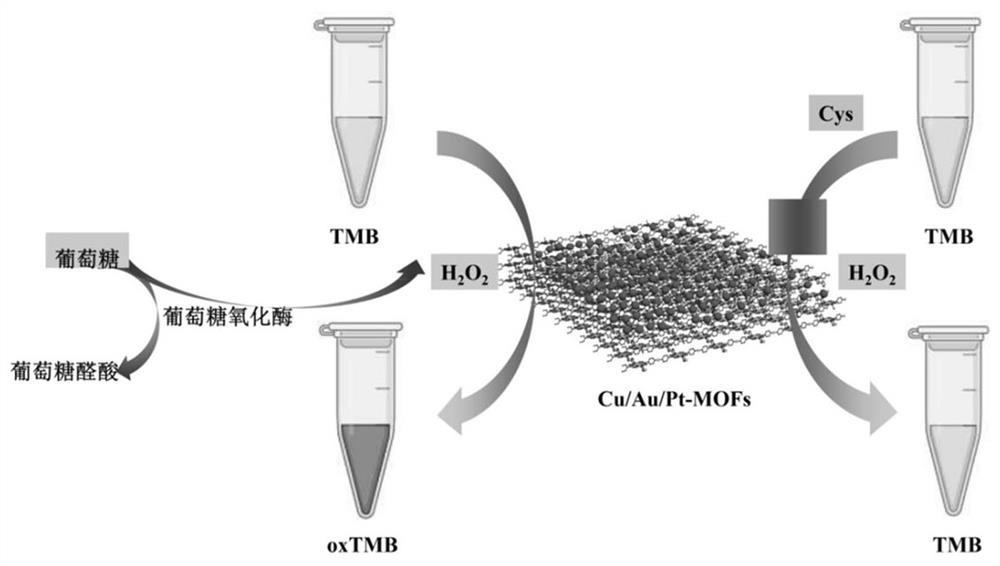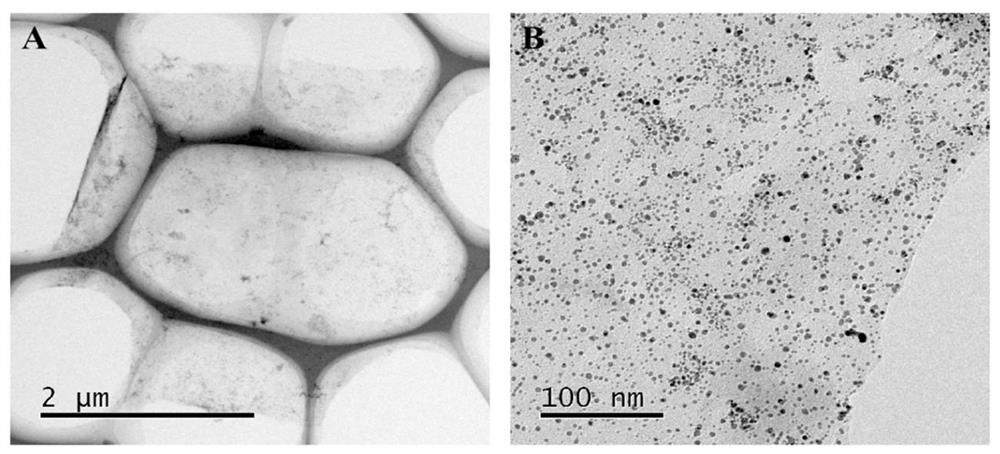Application of cu/au/pt-mofs and their visual test strips in the detection of h2o2, cys or glucose
A technology of H2O2 and test paper, which is applied in the field of nanomaterials and its analysis applications, can solve the problems of complex detection process, long detection time and low detection sensitivity, and achieve the effect of high sensitivity determination, simple operation and strong peroxidase activity
- Summary
- Abstract
- Description
- Claims
- Application Information
AI Technical Summary
Problems solved by technology
Method used
Image
Examples
Embodiment 1
[0043] Detection of H based on Cu / Au / Pt-MOFs composites 2 O 2 The method, the Cu / Au / Pt-MOFs composite materials are composed of Cu-TCPP (Fe) and Cu / Au / Pt NPs grown in situ on their surfaces, the mass ratio of Cu-TCPP (Fe) and Cu / Au / Pt polymetallic nanoparticles is 1:1.57, and the mass ratio of Cu / Au / Pt polymetallic nanoparticles is 1:5.78:4.52.
[0044] First, the preparation method of Cu / Au / Pt NPs-MOFs, the specific steps are as follows:
[0045] Divide 0.012 g Cu(NO 3 ) 2 ·3H 2O (0.01 mmol), 50 μL trifluoroacetic acid (1.0 M), and 50.0 mg polyvinylpyrrolidone dissolved in a mixture of 60 mL DMF and ethanol (V:V=3:1). Dissolve 0.022 g TCPP(Fe) (0.005 mmol) in a 20 mL DMF and ethanol (V:V=3:1) mixed solution dropwise into the above mixed solution under stirring. Then, the solution was sonicated for 10 min, placed in a reactor and heated to 80 °C and maintained for 15 h. The resulting dark brown product was washed twice with ethanol and collected by centrifugation at 8000 rpm, 25 °...
Embodiment 2
[0054] A method based on Cu / Au / Pt-MOFs composite material detection Cys, Cu / Au / Pt-MOFs composite material is prepared by the method of Example 1, the operating steps are as follows:
[0055] Add 20 μL of TMB (6 mmol / L), 10 μL of 10 μL of NOAc buffered solution (0.01 M, pH 5.5) to 135 μL of NaOAc buffered solution 2 O 2 (20 mmol / L), 25 μL Cu / Au / Pt NPs-MOFs, and 10 μL of Cys solutions of different concentrations were measured using an UV-Visible spectrophotometer after 15 min of the reaction at room temperature.
[0056] as Figure 6 The UV-Vis absorption spectrum shown shows that the absorbance decreases with the increase of Cys concentration in the range of 0-700 μM, and in the range of 0 μM to 300 μM, the absorbance at 652 nm is linearly related to the Cys concentration, and the regression equation is Δ = -0.00592 C + 1.6884(R 2 = 0.9068)( Figure 7 )。 Based on the results of 11 blank samples, a detection limit of 0.51 μM was calculated using the formula LOD = 3S / K (S is th...
Embodiment 3
[0058] A method for detecting glucose based on Cu / Au / Pt-MOFs composite material, Cu / Au / Pt-MOFs composite material is prepared by the method of Example 1, the operating steps are as follows:
[0059] First, 10 μL of 8 mg / mL of glucose oxidase solution was added to 290 μL of glucose solution of different concentrations and mixed well, incubated in a metal bath for 15 min. Then, take 10 μL of the above incubation solution and add 135 μL to NaOAc buffer solution containing 20 μLTMB (6 mmol / L), 25 μL Cu / Au / Pt NPs-MOFs (0.01 M, pH 5.5), after letting the reaction sit for 15 min at room temperature, measure the absorbance of the reaction system at 652 nm using an ultraviolet-visible spectrophotometer.
[0060] from Figure 8 It can be seen that the absorbance at 652 nm increases with the increase of glucose concentration, and in the range of 0 μM to 800 μ M, the absorbance at 652 nm is linearly related to the glucose concentration, and the regression equation is ΔA = 0.00396 C + 0.1...
PUM
 Login to View More
Login to View More Abstract
Description
Claims
Application Information
 Login to View More
Login to View More - R&D
- Intellectual Property
- Life Sciences
- Materials
- Tech Scout
- Unparalleled Data Quality
- Higher Quality Content
- 60% Fewer Hallucinations
Browse by: Latest US Patents, China's latest patents, Technical Efficacy Thesaurus, Application Domain, Technology Topic, Popular Technical Reports.
© 2025 PatSnap. All rights reserved.Legal|Privacy policy|Modern Slavery Act Transparency Statement|Sitemap|About US| Contact US: help@patsnap.com



